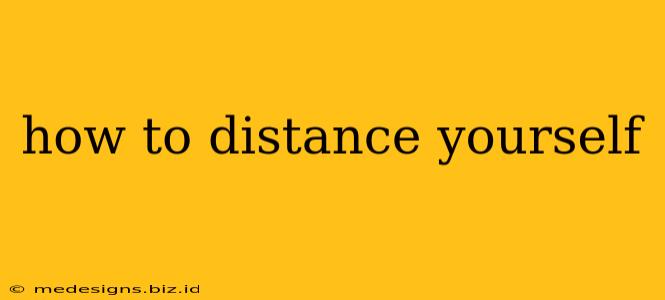Feeling overwhelmed, drained, or constantly putting others' needs before your own? It might be time to learn how to distance yourself. This isn't about becoming isolated or unfriendly; it's about establishing healthy boundaries to protect your mental and emotional well-being. This guide will explore various scenarios and techniques to help you create the necessary distance for a happier, healthier you.
Understanding the Need for Distance
Before diving into how to distance yourself, it's crucial to understand why it's necessary. Sometimes, relationships, situations, or even habits become toxic, draining your energy and hindering your personal growth. This can manifest in several ways:
- Toxic Relationships: Dealing with manipulative, controlling, or consistently negative individuals can leave you feeling depleted and stressed.
- Overwhelming Responsibilities: Taking on too much, whether at work, home, or in social circles, can lead to burnout and anxiety.
- Unhealthy Habits: Addictive behaviors, negative self-talk, or procrastination can significantly impact your mental and physical health.
Recognizing the Signs: Are you experiencing:
- Constant Anxiety or Stress: Do you feel on edge, even when things seem calm?
- Physical Symptoms: Headaches, stomach problems, or sleep disturbances can be signs of emotional stress.
- Low Self-Esteem: Do you constantly feel inadequate or undervalue yourself?
- Feeling Drained: Do you lack energy and motivation, even after resting?
If you resonate with these signs, learning to distance yourself might be a crucial step toward self-care and recovery.
How to Create Distance in Different Situations
The approach to distancing yourself will vary depending on the situation. Here are some practical strategies:
1. Distancing from Toxic Relationships
- Reduce Contact: Gradually decrease the frequency and duration of your interactions.
- Set Boundaries: Clearly communicate your limits and what behaviors you won't tolerate. This might involve saying "no" more often.
- Limit Emotional Investment: Avoid getting drawn into their drama or negativity. Focus on your own well-being.
- Seek Support: Talk to a trusted friend, family member, or therapist about your experiences.
2. Distancing from Overwhelming Responsibilities
- Prioritize Tasks: Focus on the most important tasks and delegate or eliminate less crucial ones.
- Learn to Say No: Don't overcommit yourself. It's okay to decline requests.
- Time Management Techniques: Utilize tools like calendars and to-do lists to manage your time effectively.
- Break Down Tasks: Large projects can feel overwhelming. Divide them into smaller, manageable steps.
3. Distancing from Unhealthy Habits
- Identify Triggers: Understand what situations or emotions lead to these habits.
- Seek Professional Help: Consider therapy or support groups for addiction or other behavioral issues.
- Replace Unhealthy Habits: Find healthy alternatives to cope with stress or negative emotions.
- Self-Compassion: Be kind to yourself throughout the process. Setbacks are normal.
Maintaining Distance and Protecting Your Boundaries
Once you've created distance, it's essential to maintain it. This involves ongoing self-care and assertiveness:
- Self-Care Practices: Prioritize activities that nourish your mind, body, and spirit, such as exercise, meditation, or spending time in nature.
- Assertiveness Training: Learn how to communicate your needs and boundaries effectively without feeling guilty or apologetic.
- Regular Self-Reflection: Periodically assess your boundaries and adjust them as needed.
Remember: Distancing yourself is an act of self-love and self-preservation. It’s not selfish; it’s essential for your well-being. By setting healthy boundaries and prioritizing your mental and emotional health, you'll create space for personal growth and a more fulfilling life. If you are struggling, seeking professional help is a sign of strength, not weakness.
